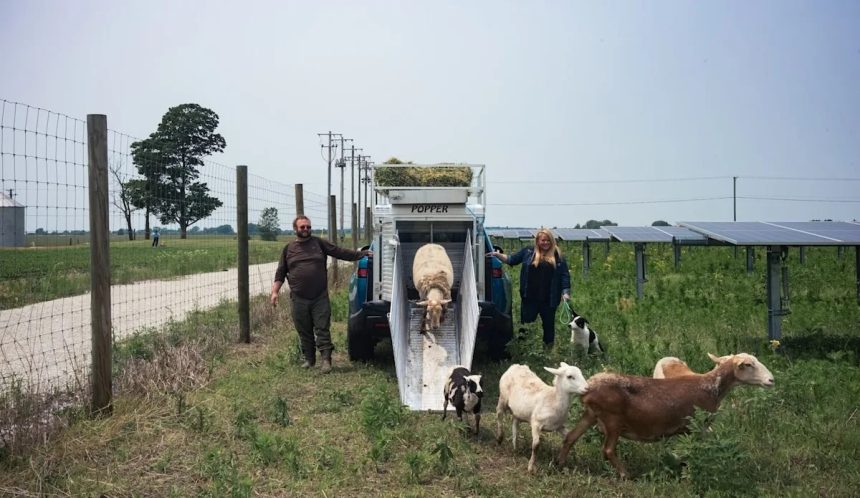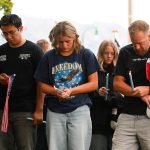To all the challenges the solar industry is facing today, add one more: cultivating a domestic market for lamb meat. It may seem an unlikely mission for clean-energy developers, but in many states, including Illinois, grazing sheep between rows of photovoltaic panels is considered the most efficient form of agrivoltaics — the combination of solar and farming on the same land.
Solar advocates, researchers, and developers have given much attention to agrivoltaics. The practice includes growing crops like blueberries, tomatoes, or peppers in the shade of solar panels and letting cows or sheep graze around the arrays.
Perhaps the biggest benefit of agrivoltaics is that land is not being taken out of agricultural production in favor of clean energy, a concern that has stoked intense opposition to solar. The Trump administration codified this sentiment when the head of the U.S. Department of Agriculture announced on Aug. 19 that the agency “will no longer fund taxpayer dollars for solar panels on productive farmland.”
Illinois’ sprawling fields of corn and soybeans don’t coexist well with solar panels, but sheep do, making grazing a promising type of agrivoltaics for the state, proponents say.
In a typical solar grazing arrangement, sheep farmers (called grazers) are paid by solar developers to bring the animals to sites hosting large arrays — often farms — where they munch away on the vegetation. Meanwhile, the landowner benefits from lease payments. Grazing is a lower-emissions alternative to mechanical mowing, and sheep can reach corners that mowers can’t.
But to make a living herding sheep, the grazers need to be able to sell the lambs they raise as meat. In the U.S., lamb is sold primarily in halal markets and appears on menus only during Easter holidays. Three-quarters of that meat is imported from Australia and New Zealand.
“What there needs to be, honestly, is more demand for lamb in the country,” said Stacie Peterson, executive director of the American Solar Grazing Association, which offers solar grazing certifications and contract templates. “We’re hoping to help develop more breeding stock, more farmers, more grazers doing this.”
A taste for lamb
Brooke Watson would like to see demand for lamb soar in the Midwest, in tandem with demand for solar grazing. Brooke’s husband, Chauncey Watson IV, has been raising sheep since he was in 4-H, a program that teaches kids about agriculture. Chauncey’s family has farmed in Illinois since 1856. The couple has raised lambs and sheep for wool, but in 2023 they bought a new flock of “hair sheep,” which don’t need shearing, to give solar grazing a try. “Hooves on the ground” happened last summer, Brooke said. Now they have 500 ewes grazing on over 320 acres at nine community solar sites in six Illinois counties.
Brooke laments that Americans “lost their taste for lamb” after World War II — because veterans had grown tired of wartime canned lamb rations, according to some accounts. (Other historical factors also likely influenced the decline in mutton’s popularity.)
“It has picked up in the last few decades, but more so with immigrant communities, where lamb is that really valuable cultural and religious product,” she said, adding that “traditional beef and chicken consumers” should give lamb a chance. “There’s really a huge, huge potential for both of these industries to grow and evolve together side by side.”
Brooke said solar grazing can also provide a way for younger farmers to stay in the business.
“The landowner most typically is hitting retirement age, and they don’t want to work the land anymore. So solar is a way for them to still maintain ownership of that parcel, and they’re compensated to host the solar on the site” while collaborating with farmers like her and her husband, who are typically “younger, maybe first generation or newer farmers, and they’re excited about the sheep grazing.”
A novelty in Illinois
According to a census by the American Solar Grazing Association and the National Renewable Energy Laboratory, sheep solar grazing is concentrated in the West and the South. In 2024, almost 62,000 sheep were grazing over 87,000 acres at 109 solar sites in the South, with more than half of the animals in Texas. In the Midwest, including Illinois, just over 13,000 sheep grazed almost 7,000 acres of solar at 148 sites.
Texas and California have long histories of shepherding, and in many areas sheep are central to the ranching culture. That means grazing sheep under solar panels is continuing these areas’ traditional agriculture.
But in Illinois, there is little history of raising sheep. So converting acres of the state’s primary corn and soybean fields may still raise eyebrows.
“In Europe, solar grazing has taken off, but they are much more into sheep,” said Ken Anderson, director of the Advanced Energy Institute at Southern Illinois University. “When you see sheep move into Illinois, it’s unfamiliar to people; they’re not used to seeing sheep. It’s better with cattle, but cattle are harder — they like to scratch. It can do damage to the panels.”
Solar grazing goats, meanwhile, has been “a disaster,” Anderson said, because they chew wires and other parts of solar arrays. He is working on a proposed agrivoltaics research site that would grow peaches, apples, and other specialty crops amid solar panels on a former military munitions site in Illinois. Anderson prefers growing crops under panels to grazing, but crops need more specialized solar configurations.
Solar panels suited for sheep are “strictly industrial arrays,” he said. “All you’re going to be able to do is graze sheep there in the future, so you need to think about the long haul.”
Sheep may be the state’s best option for large arrays because, Anderson thinks, there’s limited potential for solar panels to occupy the same land as the state’s traditional sprawling corn and soybean fields.
“In my opinion, the economics will never work,” for pairing corn and soy with solar, Anderson said. “When you grow broad-acreage crops like corn and soy, you use very large equipment, so you have to put the panels far apart,” resulting in less energy output.
While solar grazing in Illinois might often replace corn or soybean production, Watson sees it as a positive trade-off.
“So much of that corn is used for ethanol production, and so much of that soy is, quite frankly, exported to other countries,” she said. “So we really look at solar grazing as an opportunity to have more U.S.-sourced energy production and food production as well.”
The Watsons work with a solar developer called Pivot Energy. Since 2021, agrivoltaics has been the company’s main focus, according to director of operations and maintenance Angie Burke. In Illinois, Pivot Energy has 365 sheep grazing at 11 sites, and those numbers are projected to more than double by next year.
“Agrivoltaics is this great way to support those family farmers locally and provide that cost-competitive, locally sourced, and high-protein-value food for those communities that are excited to eat more lamb,” Burke said.
Improving the land
While solar grazing may not be more profitable than mechanical mowing for landowners, it leaves the soil in better condition than if it were left idle under the panels.
“Let’s be delicate — [the sheep] are contributing to the soil” with their excrement, said Anderson.
In climates like Illinois’, sheep must be housed and fed inside during winter — a considerable expense. But Brooke Watson noted that, unlike solar grazers in Western states, she and her husband don’t need to provide much water for sheep in summer, as the lush vegetation and frequent rain suffice. In any state, solar grazing means ensuring that there are safe fences or wires around sites and that predators are kept out.
“In the early days, there were some horror stories where people dropped sheep off and came back at the end of the summer and there weren’t any sheep anymore,” said Ethan Winter, national smart solar director of American Farmland Trust, an organization committed to farmland preservation and sustainable farming practices. “You’re starting to see more professionalization, more formalized best practices for grazers.”
The organization United Agrivoltaics connects would-be grazers with solar developers and provides resources for insurance and contracts, Winter added.
American Farmland Trust’s Midwest solar specialist Alan Bailey noted that existing crop residue or debris must be cleared and specific cover crops planted to prepare for solar grazing, but this can happen while an array is being built. “One of our principles is having some sort of living cover on those sites throughout the entire construction process,” he said.
Because solar grazing’s benefits to the land and environment are well established, Winter said, boosting the lamb market is “the next big step” for expansion.
“There’s both the need and opportunity to think about markets for the lamb,” Winter said, noting that the animals could be sold to wholesale processors or marketed locally. “There may be a real advantage in having the Illinois Solar Lamb label.”









